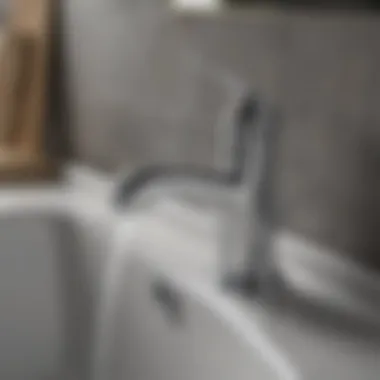Complete Guide to Delta Bathroom Sink Faucet Repairs


Intro
Repairing a bathroom sink faucet may seem like a daunting task at first glance, but with the right knowledge and tools, any homeowner can take it on with confidence. When it comes to Delta bathroom sink faucet repair kits, understanding their components, uses, and the nuances of repair can turn a frustrating issue into an easy fix. These kits are not just collections of random parts; they are specifically designed to address common problems that can arise in bathroom faucets, ensuring that functionality is restored without necessitating a full replacement.
In this guide, we're going to peel back the layers on Delta repair kits, detailing not only what makes them essential but also how to use them effectively. We’ll dive deep into the components included in various kits, walk through step-by-step repair processes, and shed light on the typical issues you might encounter with your faucet. Furthermore, we’ll share valuable maintenance tips, enabling you to prolong the life of your bathroom fixtures.
Whether you're a seasoned DIYer or a novice looking to save on plumbing costs, this article aims to empower you. By the end of it, you should feel equipped to confidently tackle your faucet repair projects, enhancing both the efficiency and lifespan of your bathroom fixtures. Let's get started on this journey to a more functional bathroom!
Prologue to Delta Bathroom Sink Faucets
When it comes to bathroom fixtures, Delta faucets hold a special place in the hearts of homeowners. These products are not merely about aesthetics; they encapsulate functionality, durability, and innovation. The significance of understanding Delta bathroom sink faucets lies in the fact that they blend form and function seamlessly, elevating the usability of any bathroom space. Just think about it—every drop of water that flows through a malfunctioning faucet can lead to frustration and unnecessary water bills.
Having a reliable faucet in your bathroom can make your morning rituals smoother. It’s like having a trusty companion that never lets you down. And when those trusted faucets start to show signs of wear and tear, knowing how to fix them can save you from costly plumbing bills and extensive inconveniences.
Understanding these faucets is the first step in ensuring their longevity. That's where this guide shines, equipping homeowners with the insights they need to tackle faucet issues like a pro.
Overview of Delta Faucets
Delta faucets are renowned for their innovative designs and high-quality materials. They come equipped with a variety of features that make faucet operation easier and more efficient. For example, Delta's trademarked ToucO technology allows users to turn the water on and off with just a tap of the faucet body. This keeps the faucet cleaner and reduces the spread of germs, especially important in a space defined by hygiene.
Moreover, Delta bathrooms sink faucets are available in various styles, catering to both modern and traditional tastes. Homeowners can choose finishes ranging from polished chrome to matte black, allowing them to find a suitable pair for their decor. Not just that, but many Delta faucets offer a lifetime limited warranty—a nod to their durability and the brand's commitment to quality.
Importance of Faucet Repairs
Proper functioning of bathroom faucets is integral to the overall usability of the space. When faucets are in disrepair, minor annoyances can quickly escalate into substantial issues. Drips, leaks, and inconsistent water flow are not only irksome; they can lead to water damage or mold growth if left unattended. It’s like ignoring a small crack in your wall—what starts as a minor issue can turn into a major repair need later.
Thus, grasping the importance of repairs becomes critical. Regular maintenance can extend the life of your Delta faucet, ensuring it performs smoothly for many years. Plus, learning the ropes of repair can arm you with the knowledge needed for quick fixes at home, making interactions in the bathroom less of a hassle.
In essence, empowering yourself with knowledge about Delta bathroom sink faucets and their repair kits turns the chore of fixing into a manageable—and often satisfying—project.
Understanding Repair Kits
When it comes to maintaining the functionality of a Delta bathroom sink faucet, having a clear understanding of repair kits is paramount. These kits can play a significant role in ensuring seamless water flow and longevity of your fixtures. Repair kits are not simply a collection of parts; they are thoughtfully curated to address common issues faced by homeowners. Without the right kit, troubleshooting can turn into a costly endeavor where time and resources may be wasted. Therefore, it’s essential to explore the various aspects of repair kits that can lead to effective repairs and ultimately, satisfaction in keeping your home running smoothly.
Definition of Repair Kits
Repair kits, in the context of Delta bathroom sink faucets, are tailored packages that include all the necessary components required to fix specific faucet issues. Typically, these kits contain a variety of parts such as washers, seals, cartridges, and o-rings, each designed to target particular problems like leaks or drips. In simpler terms, when you think of a repair kit, imagine it as a toolbox on a smaller scale; it equips you with the essentials to rectify malfunctions without the need for professional plumbing help. Often, the kits come with detailed instructions, making them accessible even for those who are not particularly handy.
Types of Repair Kits Available
There’s no one-size-fits-all when it comes to repair kits for Delta faucets; the type you choose often hinges on the issue you’re facing. Here’s a look at several types of repair kits you might encounter:
- Cartridge Repair Kits: These are ideal for faucets that use cartridge mechanisms, focusing specifically on replacing worn-out cartridges that can cause leaks.
- O-Ring Kits: Sometimes, a simple o-ring replacement can work wonders. These kits typically contain various sizes of o-rings to tackle different points of wear in the faucet assembly.
- Seal Kits: Seal kits address leaks that might arise between the faucet and sink. They include seals designed to fit snugly and prevent moisture escape.
- Complete Repair Kits: These kits offer a comprehensive selection of parts covering multiple issues from faucets that tend to drip to those that have completely stopped functioning.
By understanding the types of repair kits available, homeowners can better equip themselves to choose the right one for their needs, ensuring proficient repairs and well-maintained faucets.


Components of Delta Repair Kits
Understanding the components of Delta repair kits is crucial for any homeowner or DIY enthusiast aiming to maintain their bathroom sink faucet. A faucet is more than just a fixture; it is a central part of your daily routine. When something goes awry, having a repair kit can make a world of difference. Not only do these kits save you time and money, but they also put the power of repair directly into your hands.
Repair kits for Delta faucets generally include a variety of essential parts. Each component is designed with a specific function in mind, ensuring that your faucet operates smoothly once again. By familiarizing yourself with what's inside these kits, you can approach repairs with confidence, knowing you have the right tools at your disposal.
Common Parts Included
When you open a typical Delta faucet repair kit, you'll find several common components that are vital for fixing various issues. Some of the main parts often included are:
- O-Rings: These are essential for creating a watertight seal, preventing leaks.
- Cartridges: The heart of the faucet that controls water flow and temperature. A malfunctioning cartridge is often the culprit behind drips or inconsistent flow.
- Springs: Helps retain pressure in the faucet and ensures that the components fit snugly together.
- Washers: These small parts act as a buffer against wear and tear and help in sealing joints to prevent leaks.
- Retaining Nuts: Keep the faucet assembly together; without them, the entire unit could come apart.
Having a look at these components reveals how integral they are to the performance and longevity of your Delta faucet. For instance, a worn-out O-ring can turn a minor seep into a major drip. Addressing these issues swiftly ensures that your faucet runs effectively and can even save you from costly water bills.
Tools Required for Installation
To effectively use the components from your Delta repair kit, you will need some basic tools. Having the right tools makes installation smoother and saves you from potential headaches down the line. Recommended tools include:
- Flat-head Screwdriver: Useful for prying off covers or caps without damaging the faucet.
- Phillips-head Screwdriver: For removing screws from the faucet and connecting parts.
- Adjustable Wrench: Assists in tightening or loosening nuts without slipping.
- Pliers: Handy for gripping small parts or firmly securing components.
- Teflon Tape: Often overlooked, but this tape provides a better seal on threaded connections, preventing leaks.
These tools can usually be found either in your garage or an average household toolbox. If you're missing any, they can be procured from local hardware stores without breaking the bank.
Overall, knowing the components of Delta repair kits and having the right tools readily available will empower you in your repair efforts, ensuring your faucets are functional and leak-free for years to come.
Identifying Faucet Issues
When it comes to keeping your Delta bathroom sink faucet in tip-top shape, the first step is spotting any issues before they snowball into larger problems. Knowing how to identify faucet issues effectively not only saves time and frustration but also ensures you make the right choice when selecting a repair kit. Tackling faucet problems promptly is like nipping a weed in the bud; it keeps your entire plumbing system running smoothly.
Common Problems in Bathroom Faucets
Bathroom faucets, despite their sturdy design, can encounter various common problems. Here are some issues you might run into:
- Leaky Faucets: A classic headache, leaks can stem from worn-out washers or seals. Water dripping from your faucet isn't just an annoyance - it can raise your water bill significantly.
- Low Water Pressure: If it feels like you're trying to wash your hands with a trickle rather than a stream, there could be a blockage or an issue with the aerator.
- Stuck Handles: Sometimes, the handle might refuse to budge. This situation usually indicates some internal wear or debris caught in the mechanism.
- Unusual Noises: If you hear whistling, banging, or odd gurgling noises when using your faucet, it’s likely due to air bubbles in the pipes or a faulty cartridge.
"Diagnosing the right problem is half the battle won!"
Diagnosing the Issue
Diagnosing the issue is crucial to ensure you're addressing the right problem. Here’s a simple guide to help you through:
- Inspect for Leaks: Start by looking under the sink and around the faucet. Don't forget to check the connections at the supply line and where the faucet meets the sink.
- Examine the Flow: Turn the faucet on fully. Is the flow steady? Check if the aerator is clogged by removing it and seeing if the flow improves.
- Check the Handle Movement: Test the handle to see if it operates smoothly. If there's resistance, it might indicate an internal issue.
- Listen Carefully: As you run the faucet, pay attention to any unusual sounds. If you hear anything out of the ordinary, make a note; failing components often announce themselves loudly!
Step-by-Step Repair Process
The repair process for a Delta bathroom sink faucet is a crucial part of maintaining functionality and extending the life of your plumbing fixtures. Effectively addressing problems as they arise not only saves money on potential service calls but also empowers homeowners to take control of their own maintenance. By understanding each phase, from preparation to testing, one can navigate the intricacies of faucet repairs without getting lost in the details.


Preparation for Repair
Before diving headfirst into the repair process, preparation is key. Gather all your tools and parts ahead of time. Commonly needed items may include:
- Adjustable wrench
- Screwdriver set
- Pliers
- Towels or rags
- Replacement parts from your repair kit
Start by ensuring your workspace is clean and has adequate lighting. It’s helpful to close the water supply lines using the shut-off valves. Make sure to drain any remaining water by running the faucet. This step is not merely tedious; it's an essential part of the process. Taking these precautions minimizes mess and mitigates the risk of unexpected surprises.
Disassembling the Faucet
Next comes the disassembly - arguably the most critical part of the repair. Once you have disabled the water supply, you can proceed to remove the faucet handle. Carefully inspect how it is attached; some might require unscrewing, while others might just pop off. Keep track of all screws and small pieces to avoid losing them.
When disassembling, be mindful of how parts fit together. Taking pictures at each stage can serve as a useful reference when you’re reassembling later. It’s often said that a picture is worth a thousand words, and in this case, it may save you from a thousand headaches.
Installing New Parts
With the faucet disassembled, it’s time for the fun part: installing new parts. Refer to your repair kit’s instructions. If you have replaced washers or seats, make sure they fit snugly. A little extra effort in this stage can save you from leaks later.
Be gentle yet firm when installing parts. Too much force can damage delicate components. After placing each part, double-check your work. Ensuring proper alignment at this stage can make all the difference in achieving a watertight seal.
Reassembling the Faucet
Once the new parts are in place, it’s time to put everything back together. This might feel like solving a puzzle - everything should fit snugly like the pieces of a jigsaw. Pay attention to the order and arrangement of parts.
Use your photographs or notes from the disassembly phase as a guide, which can help you avoid common mistakes. As you reattach the faucet handle and other components, confirm that they move seamlessly. No misaligned knobs or stubborn handles should survive the process.
Testing the Faucet
Now for the final test - literally. After reassembling, it’s essential to turn the water supply back on gradually. Be alert for any signs of leaks during this phase. If water flows smoothly without leaks, you’ve successfully completed your repair! If issues arise, double-check the assembly, as it’s often a simple oversight.
Important Note: Testing should always be done cautiously. Sudden pressure spikes can lead to damages, so it's preferable to restore the water flow slowly.
In summary, following these steps diligently ensures not just a fixed faucet, but also a deep sense of accomplishment. The world might be busy, but taking the time to properly repair your faucet can make the small, often overlooked moments all the more rewarding.
Maintaining Your Delta Faucet
Maintaining your Delta faucet is not just an act of responsibility; it is a crucial step to ensure longevity and optimal performance. Regular upkeep helps avoid minor issues turning into major repairs, saving you money and hassle in the process. A well-maintained faucet not only enhances your bathroom's aesthetic but also improves water efficiency, which is key in today’s world where conserving resources is vital.
Taking pride in your fixtures translates to a more enjoyable user experience. Imagine turning on the faucet and having water flow seamlessly without hissing, dripping, or unruly sprays. That kind of peace of mind stems from consistent maintenance and an understanding of when to intervene when issues arise.
To maintain your Delta faucet effectively, it's essential to know the routine checks and preventive measures you should take. It's not a complicated task, but recurring diligence can make a significant difference in functionality over time.
Regular Maintenance Tips
Here are a few simple tips to keep your Delta faucet in prime condition:


- Inspect Regularly: Periodically check for any visible leaks or drips. A small leak can escalate quickly if left unattended.
- Clean Aerators: Mineral deposits can clog your faucet's aerator, leading to poor water flow. Removing and cleaning it with vinegar every couple of months can work wonders.
- Use Gentle Cleaners: Rely on gentle, non-abrasive cleaners to wipe down your faucet. Harsh chemicals can damage the finish.
- Check Water Pressure: Abnormal pressure can indicate underlying issues. A pressure gauge can help you monitor this aspect.
- Lubricate Moving Parts: A little silicone grease on the cartridge of your faucet helps keep things running smoothly.
- Monitor Your Water Quality: Contaminants can cause wear and tear on faucet parts. Installing a water filter can be beneficial, not just for health but also for your faucets.
By incorporating these practices into your routine, you set the stage for a faucet that runs well years down the line.
Signs You Need a Repair Kit
Not all faucet issues scream for immediate repair, but certain signs should definitely raise red flags. Here’s what to watch out for:
- Frequent Dripping: If your faucet is dripping after you turn it off, that’s a clear sign of a worn valve seat or O-ring that may need replacement.
- Unusual Noises: Gurgling or rattling noises are not normal and might indicate a loose part.
- Low Water Pressure: A sudden drop in water pressure should not be ignored. It might mention sediment buildup or more significant plumbing issues.
- Leaking at the Base: If you notice water pooling around the base of the faucet, you likely have a seal issue, which calls for immediate attention.
- Corrosion or Rust: Any signs of rust or corrosion indicate that it might be time for a more significant update and possible kit installation.
Addressing these concerns swiftly can prevent extensive water damage and expensive repairs down the road.
In summary, maintaining your Delta faucet isn't solely about avoiding repairs; it's about enriching your daily routines and extending the life of your fixtures. By following consistent maintenance routines and being vigilant about the signs of possible repairs, you're not just upkeeping a fixture but investing in the comfort and efficiency of your home.
Frequently Asked Questions
In any technical endeavor, particularly when it relates to home improvement, a solid understanding of frequently asked questions can make a world of difference. Looking at Delta bathroom sink faucet repair kits, this section demystifies commonly raised queries and provides clarity to homeowners who might feel overwhelmed. It highlights the necessity of addressing standard concerns, which in turn minimizes confusion and equips readers with more confidence to proceed with their repairs.
Understanding these frequently asked questions not only prepares the homeowner for the repair task but also fosters smarter decision-making. Being well-informed ensures that one chooses the right repair kits, thereby increasing the likelihood of successfully addressing faucet issues.
How to Choose the Right Repair Kit?
Choosing the appropriate repair kit for your Delta bathroom sink faucet is crucial for the entire repair process. Not all kits are created equal, and selecting one that doesn’t suit your faucet model can lead to further complications. When it comes to finding the right kit, consider these key factors:
- Know Your Faucet Model: One of the first steps is identifying your specific faucet model. Delta has a variety of styles, and each may require a different repair kit. Look for model numbers on the faucet body or consult documentation that came with your faucet.
- Types of Repair Kits: Understanding the types of repair kits available can also help streamline your decision. Some kits focus on specific components, like cartridges, while others are more comprehensive, including assorted parts. Look for kits that cater to the most common issues that your faucet is facing.
- Quality of Components: not all products on the market are made of the same quality materials. It pays to invest a tad more for reliable components that would last longer. Check reviews or ask for recommendations from friends or online communities.
- Instructions and Support: Purchasing a kit from a reputable source with good customer support can provide an added layer of assurance. Instruction manuals that accompany the kit should be clear and straightforward, guiding you through the repair process seamlessly.
What If the Repair Does Not Solve the Problem?
So, you've gone through the hustle of selecting and using a repair kit, only to find that the faucet is still not functioning as it should. It's a disheartening situation, but don’t lose heart just yet. Here's what you can consider if your initial repair doesn't yield the desired results:
- Double Check Your Work: Sometimes, the simplest mistake during installation can be the root of the problem. Review your steps—are all the parts reassembled properly? Were any seals or O-rings overlooked?
- Consider Other Factors: It’s essential to remember that faucet problems can stem from various underlying issues. If the leak persists, it might not be solely due to the cartridge or parts replaced. Problems could also lie deeper in the plumbing or piping system.
- Look for Professional Assistance: If you’ve checked everything and still see no results, turning to a licensed plumber might be the best route. Getting a professional to evaluate the situation can save you from unnecessary headache and potential further damage.
- Evaluate the Kit Quality: If you've used one of the less reliable kits, that could also be a factor. Sometimes parts just don’t fit well or fail quickly. In such cases, returning to the store for an exchange or upgrading your kit might be sensible.
In summary, whether it’s fessing up to a mistake or realizing the complexity of plumbing issues, understanding what to do should your repairs not pan out is just as crucial as executing the repair correctly.
Closure
Wrapping up the insights we've explored around Delta bathroom sink faucet repair kits, it's clear this topic holds significant importance for homeowners and particularly for those aiming for a DIY approach. Understanding these kits not only paves the way for efficient repairs but also contributes to the overall longevity and functionality of your faucets.
Final Thoughts on Repair Kits
Repair kits represent an essential aspect of faucet maintenance. They contain the specific components required to mend common issues that arise in Delta bathroom sinks. Having a dedicated repair kit at hand means you’re not relying solely on a plumber every time a problem crops up. Instead, you can spring into action and rectify minor leaks or performance issues promptly. This not only saves you time and money but also enhances your skills over time. When you learn to address these repairs yourself, you obtain a deep, hands-on understanding of your fixtures, ensuring you can tackle future issues with confidence.
It's essential to choose the right kit, matching the parts to the specific model of your faucet. This careful selection guarantees that you're prepared for anything that might go wrong. Moreover, with a bit of practice, the anxiety tied to DIY repairs often transforms into a sense of achievement.
Encouragement for DIY Repairs
So, why not take the plunge into DIY repairs? Many homeowners shy away from handling plumbing tasks, often feeling out of their depth. However, tackling faucet issues is much more manageable than it seems. With some basic tools, a repair kit, and a bit of guidance, you'll find you can resolve these issues yourself.
Engaging in DIY repairs can also be quite rewarding. As you see the fruits of your labor blooming, the satisfaction grows. Besides, embracing these hands-on projects can be a great way to bond with family members as you tackle repairs together.
If you find the thought of facing faucet repairs daunting, know that countless resources—like forums on Reddit and instructional videos on platforms like Facebook—are available. These helpful communities can offer support and guidance, decreasing that initial apprehension.
"Taking the DIY route may seem overwhelming, but each tackled project builds your confidence and skills for the next one."



